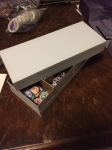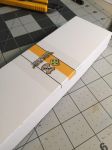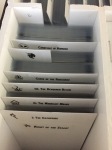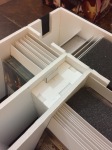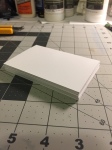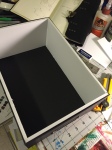Dungeon Builder: Handpainted tiles to build maps
Recently I bought a Humble Bundle that included a “dungeon builder” type of pack. It turned out that this was simply a set of images that a person would use to compose their own dungeons using an image editor such as photoshop. Well, I decided to start working on making my own! My differentiator? I wanted to create them all using watercolour paintings to give the maps a more stylish flair. I think these will end up really nice, but I thought I’d post some images of what I have so far. They’re all work in progress and I am still building more of them, but these are tiles for a basic stone dungeon pack.


At some point, I may toss them on my Etsy shop at jestermaxart.etsy.com if I get enough created and find that there is enough interest for such a pack.
Crafting album: More Dungeon Details
Here’s some pictures of some more foamcore dungeons props I’ve made this year.


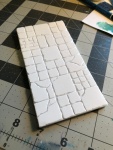
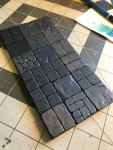
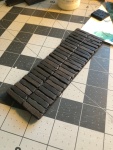
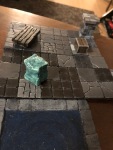
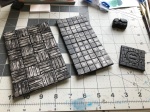

Crafting Project: Eldritch Horror Storage Solution (Part 1)
I own all of the expansions for the board game Eldritch Horror. I really enjoy this game, however, it is very cumbersome to set up and tear down this game, especially if you want to use the expansions (I previously have kept each of them separate so I could enjoy each one’s additions). I finally had some time to work on designing my own storage solution that fits into the original game’s box (The provided boxes are horrible for storing the game content).

SOME of the game content that needs to be stored
My plan was to be able to play the game out of the box. The core box would hold the majority of the game content while 1-2 of the big box expansions would hold the additional stuff like the Ancient One decks and Mythos cards (things that aren’t all used in every playthrough, etc). I’m still not done with this project, but I’ve made two substantial components, and I have designs for more stuff.
The first component is a card channel to hold the mini-cards in the game (spells, items, artifacts, etc). I didn’t really want this as a solution and the first designs were to build individual boxes with lids, but the amount of work would have been staggering to make a professional-looking set of boxes with graphics wrap using linen-finish paper. I opted for an easier route, but I made sure each type of card had its own section (as opposed to using loose cardboard dividers, which means the whole thing can fall over if you take the cards out, etc). I estimated how much room would be needed for additional expansions using a calculation of how much each previous expansion took (3 cards = roughly 1mm).
- Card channel takes up same amount of space as the left-side of the original box insert
- Permanent chipboard section dividers
EDIT: Some measurements. I used 5mm foamcore and ~2mm thick chipboard for the dividers.
Total insert dimensions: 286mm x 80mm
Cuts for the divider cards are 2mm and go down about 23mm. I didn’t actually glue them in as they had a snug fit. The spacing of the cuts are [roughly] as follows (measured from the inside of the larger box; basically minus 10mm for both ends). Also, keep in mind the sections are rearranged so the larger ones are on the outsides.
Section (assets/artifacts): 75mm
Section (conditions): 74
Section (unique assets): 67mm
Section (spells): 51mm
The next component to build was a box for the game tokens. I’ve seen other people make trays out of foamcore, but I didn’t like the idea of having everything be loose without a lid. The last time I moved, I found that many of my boardgames ended up on their side or upside down in their moving boxes. I’d hate to have to sort through everything all over again. I originally wanted a professional-looking box with list that would be graphics wrapped (possibly with a neodymium magnet in place), but again, I opted for something a bit more simple to make the scope smaller (after all, I’d like to eventually play this game and not be forever working on box inserts).
I decided on making small open-topped boxes out of ~1mm cardboard and then building a casing base and lid. I ended up not gluing these micro-boxes into the casing yet since I may still try to do a graphics wrap on them. I still need to figure out a good process to do the image work, and I’m not sure if there is enough clearance for it. The lid slides on top of it all and the whole component box can be removed.
- Each component type in its own mini-box
- Almost closed
- Sealed box
NOTE: I opted to keep the clues out of this box. I want to make a separate one so I can shake it and mix the tokens up for randomized drawing. I also didn’t add the “general” tokens. This component box fits like an “L” shape to the mini-cards section right now. I’ll add another box for the general pieces most likely or just keep them in a baggie. They are a bit larger and harder to organize.
EDIT: I was asked to provide some measurements. I’d need to clean up my schematics to get rid of the design notes, etc. but I figured I can provide some basics. Keep in mind these are the measurements I used, but could be off by a milimeter or two (based on cuts, measurement precision, and how the pieces are assembled; the cardboard is ~1mm after all)
1x Large Component Box (outer box that holds inner boxes): 199mm x 82mm x ~47mm (total height). The bottom height is 20mm and the lid’s height is 27mm.
3x Component box 1 (larger one): 80mm x 43mm x 45mm (height). Open topped
3x Component box 2 (smaller one): 65mm x 25mm x 45mm (height). Open topped. These go in a group of 3, rotated 90 degrees. They could be wider as well; I apparently did bad math or something.
Crafting Project: Heroes of Normandie component boxes
I’ve recently purchased a bunch of content for the boardgame/wargame Heroes of Normandie. My wife and I really enjoyed playing this game, but it has a lot of components that all need to be organized if you want any chance of finding anything. Each platoon in the game is represented by a large tile and each squad is another smaller tile. Each squad tile has to be kept with the platoon as well as any platoon-specific vehicles or equipment.
I decided to make a series of cardboard boxes that have the platoon markings on them to keep everything organized. The company that makes the game also has a similar thing, however, it is unreasonably expensive to have it shipped to North America. I made my own.
- Box in progress (missing side part of label)
- Three complete boxes
- Open box showing game content
Added labels to Arkham Horror card dividers
I finally bought a printer to make labels for my Arkham Horror: LCG custom dividers! I decided against using some of the full colour ones people have posted on boardgamegeek to avoid draining my printer’s ink carts. I’m mostly just happy that it will speed up my set-up time for this game. Also, many thanks to Scorpion0x17 on BGG for his work on the scenario icons. I’m missing most of the newer packs because he’s busy, but I’d have to roll my own if it weren’t for him.
- Top down view on the custom box
- Mythos Decks
- Core scenarios and stand-alones
- Dunwich Legacy scenarios
Insertable Foam Core Component Box
I’ve recently completed part 1 of my next foam core project; a component box that plugs into my first project (part 2 is just going to be a second box to sit beside the first). I designed it to be hingeless, use interlocking parts, and has a pull handle to slide the box out as well as open it. While I haven’t glued my original project yet, this one is held together using Gorilla Wood Glue. The lid of the box uses a slide & clip design via a piece of 1mm cardboard glued to the bottom of it.
I also cut some cardboard dividers for the first project; I just really like how they perfectly stack up 🙂
- The box holds all of the health and sanity tokens
- The lid slides in and clips down
- The sealed product
- The box fits snugly in the storage box
- Fresh stack of cardboard dividers
First foamcore project!
Ever since I found out that foamcore exists, I’ve wished I’d known about it sooner. I used to build things out of cardboard and even plain foam, and even at the time I wished those materials had the same properties as foamcore. It is fantastic and easy to work with. Now, keep in mind that I only have a small amount of experience in carpentry, so I apologize if use the wrong term for something.
For my first project, I decided to build a box insert for storing cards from a board game: Arkham Horror: The Card Game. This is a game where they release expansions on a monthly basis, so there are a lot of cards, and a lot of things to organize. Unfortunately, the company that manufactures the game did a poor job on the box it game in. They’re known for having boxes only designed for transportation of the game and not storage, but this one is particularly bad.
For this project I bought a photo box from Michaels (meant to store ~1000 photos) as the outer casing. I made up some sketches and calculated sizes for all of the pieces. I can post my sketches and measurements if anybody is interested in producing one of these. The inside of the box measures 280mm by 189mm.
Now, one of the defining factors of this project is that I made interlocking pieces so that glue is not entirely necessary. I *do* intend on gluing it together eventually, but I’d like to see if I plan on modifying it later. Contrary to what you might think, this didn’t actually take long. I chose to not do a box joint as the foamcore might not be sturdy enough for it, and it would be very time-consuming to cut.
This design choice is “controversial” as most foamcore projects I’ve seen either use a butt-joint (just glue the pieces together), a mitre-joint (cut 45 degree angles and joint), or a lap-joint (cut a trench out of one pieces and insert the other piece). I haven’t attempted any of these joints in a project before, but after a few tests, I wasn’t entirely happy with them. The butt-joint is said to be strong, especially if you pin the pieces together, but I don’t like the idea of only depending on glue, and I don’t want to work with pins. The mitre-joint seemed like a good option, but I didn’t want to have to buy a special cutting tool, and it seemed like I’d be asking for mismatch problems with all the components I’d have to cut. Lastly, the lap-joint seemed like a decent option, but it is a big pain to slice 4mm cuts in 5mm foamcore consistently. Cutting rabbits would also be very difficult as I’d need to chisel out the parts.
Additionally, I made finger slots on the ends of each channel so that it is easier to pull the cards out. I made decide later to cut semi-circles out of the slot (for style points), but right now they are rectangular slots.
ANYWAY! Here are some pictures of how the process went. It was really fun to work on, although my back hurts from hunching over my table to get a 90 degree cut angle.
- Designs in notebook and some of the pieces cut out
- Outer pieces fit in the box
- Initial construction of the components
- First full fitting of the components
- Final product
- Core set plus one scenario deck
EDIT: I added a last photo showing the core set of the Arkham Horror Card Game plus the first scenario pack inhabiting the box. I haven’t made dividers yet, and I was in the middle of setting up for a play-through last time I had the cards out, so there’s a random handful of cards in the center.
Arkham Horror in Coloured Pencil
This is my second attempt at using coloured pencils (Prisma Colors). It’s a picture of the cover art for the board game Arkham Horror. I’ve only casually been working on it while watching tv, so I have no idea how long it really took, but I spent more time on it than I should. Eventually, I got bored and realized I didn’t center it properly, so I stopped working on it. It is roughly 7″ by 4″ on mixed media paper.
Ascension: Chronicle of the Godslayer Board Game Review
So I had an impulse buy last weekend; I bought a new deckbuilding game; Ascension. While I haven’t had time to thoroughly test the game in-depth and appreciate or be irritated by the finer points, I feel like I’ve played it enough to make a judgement on the game. At least I feel confident enough to make an “overview judgement”.
First Impressions
The game comes in a somewhat multi-textured box. By this I mean, some parts are smooth and some have the criss-cross, plaid texture that games like Elder Sign has. It’s a little unusual that there are different parts, but whatever. Right now I feel like complaining that the box was bent when I bought it, so this is a reminder to always examine board game boxes before you purchase the game. The art on the box (and the rest of the game for that matter) isn’t low quality or anything. It is stylized, but overall it kind of felt unpolished. It is good, but not quite up to the quality of some of the art of many of the Magic: The Gathering cards.
The quality of the cards is fairly lacking. They are thin and easy to damage, so depending on how much you enjoy the game, you might want to purchase some card protectors. The downside to doing this however, is that it makes it very difficult to keep the cards in the tall stack necessary to play the game. Related to this, the game box has a section with ridges obviously meant to house and separate subsets of the cards. However, similar to the Resident Evil Deckbuilding Game, they fail at succeeding at this. The sections are too small to hold the cards and will bend/warp them if you try to jam them in. Thankfully there are two card “pits” in the box that make it simple enough to store everything.
Gameplay
The game plays out very similar to other deck building games. I would say it is closer to Resident Evil than Dominion though. Instead of a large set of cards that you can always choose from, you have a set of 3 cards that remain constant. Then there is a flop of 6 cards that you can purchase or battle, but the selection will change as cards are removed or purchased. This adds an element of strategy and luck as you will have different options available to you than the previous and next players will. Ultimately you are trying to collect more “honour” than the other players, but there are multiple ways you can do this (adding replayability). You can obtain honour points by either defeating monsters/bad guys, or you can get it by purchasing cards that are worth honour (tallied up at the end of the game).
There are two resources in the game: runes and fight. Runes let you buy resource cards to add to your deck, and Fight lets you battle monsters, which doesn’t add cards to your deck, but you typically will gain honour or other effects. I’ve only played this game a limited number of times so far, but it has become apparent that it is bad to focus solely on one resource. I attempted to only collect Rune resources so I could buy all the powerful cards, but then had my opponent kill monsters that had effects that crippled me to the point where I could not recover.
On the note of winning or losing games, it is not clear who is ahead unless you are closely watching who buys which cards. I won a couple games by making sure I purchased very high value cards instead of buying a bunch of cheaper cards. That being said, I lost a particularly gruesome game because my opponent defeated certain monsters that made me lose my high value cards. What a sad day.
Summary
This game was surprisingly fun. The randomized nature of the game gives it some good replayability. The game is simple and straightforward and the games seemed to go quickly and not drag on. It had a somewhat low price tag as well, so I feel like it was totally worth the money instead of feeling like I was just paying for an IP license or getting ripped off. I look forward to playing the game more and possibly getting one of the expansions for it.
Board game review: Elder Sign
This is a review of the board game (more accurately a card game) Elder Sign. This is a suspense-horror game set in the Arkham Horror world which is ultimately based on H.P.Lovecraft’s Cthulhu mythos. The game pits 1-8 investigators against the horrors of the unknown with the end goal of sealing away the Great Ancient Ones and preventing them from devouring the world. One of the big highlights of this game for me is that it is a Co-op game! This means that all players are working together to beat the game itself. Furthermore it’s a game that can be played solo, which in my opinion makes the game much easier to win.
Presentation
This is a game that is very well put together. The card stock is very high quality and the tokens are plentiful. The art and descriptions on all of the cards were created with detail in mind and they help to add to the general horror-feel of the game. My initial complaint was that the item cards were too small, but it turns out they’re meant to be placed in front of you instead of kept as a “hand”. The dice are all custom which means that you had better not lose any of them since you won’t easily replace them. The box that the game is packaged in was one of my lingering complaints however. A lot of card games use a gigantic box, but then block 2/3’s of it so you can only use a narrow channel for storage. This box is much better designed than say the Lord of the Rings card game box is though. The Elder Sign box has little flaps that pop up to help separate the decks of cards and all the components. I suppose I just rather would have had a small, thin box like that of Space Hulk: Death Angel so that it would travel easier. Overall, this is a game that regardless of if you like it or not, feels like it’s worth whatever money you spent on it.
Gameplay
Elder Sign is a fairly straight-forward game to play, but it is immensely satisfying. The general idea is that you visit quest locations which require the player to complete one or more tasks. These tasks are completed by rolling the set of custom dice to get specific results from them, sometimes in a specific order. On each failed roll the player loses a die, but can choose to keep one die from the previous roll. They continue to try and hit their goal until they run out of dice. If they ultimately fail their quest on their turn then bad things happen to them or all players. However if they succeed, then they claim new items to help them in future quests, and sometimes Elder Signs. Collecting elder signs are how the players win the game; if they collect enough of them then they seal away the Ancient One and save the world. Failing quests, or taking too long to collect enough elder signs will add doom tokens, which eventually cause the Ancient One to awaken. When this happens, they must battle it or be devoured (generally the players won’t stand a chance).
This game has a ton of customization options and ways to keep the game fresh. There are numerous Ancient Ones to choose from, and a big set of characters, each with their own specialties and abilities. The items in the game do things like allow additional dice to be added to the rolls or allow dice to be saved for future rolls for other players. Personally, I hate games that rely entirely on dice rolls, but this game has managed to do things right. There are many ways to skillfully enhance your chances of getting the right outcome so you’re not always left wondering why 1/6 odds are so difficult to pull off. They never quite remove that sense of suspense from the game though and you’re generally left saying “I can totally make that roll with this many dice… right?”
Summary
I’d highly suggest this game; it works great when you have too many people to play most 4-player games or not enough to make the 4-player games interesting. The quality of the whole set makes it worthwhile, and the gameplay elements give you a sense of satisfaction when you manage to pull off some difficult tasks of a quest using items and/or help from other players. As I noted earlier, the game tends to be somewhat easier when you play with less people, but it still offers a good challenge.




